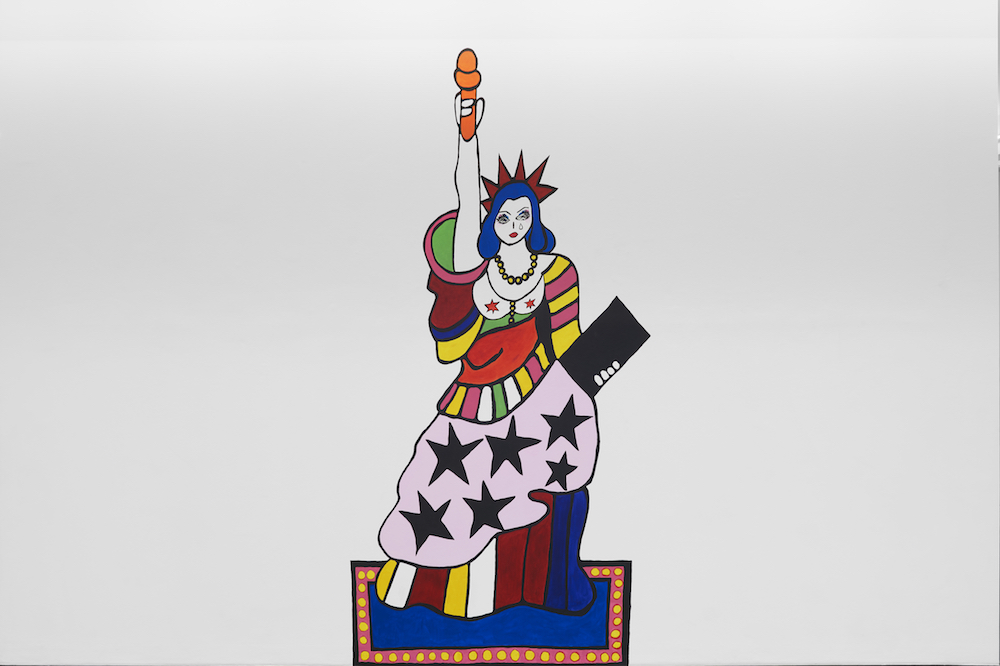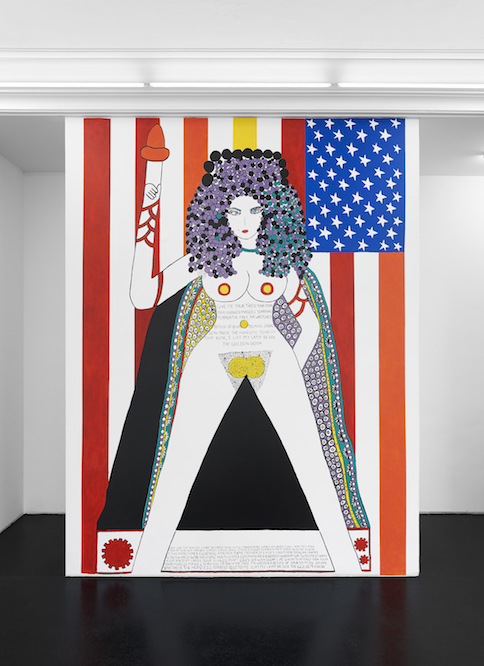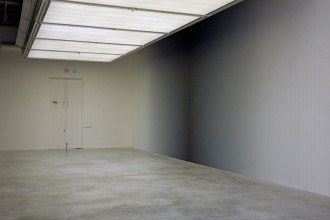Whatever else they do in this world or the next, gods take up space. Consider Dorothy Iannone’s recent exhibition Lady Liberty Meets Her Match at Peres Projects in Berlin. A suite of wall and wooden cutout paintings picture Ellis Island’s welcoming hostess – superlative goddess of American-style democracy – alongside a newfound boyfriend. Call him Lord Liberty. The pair are deities of a dubious faith: a mythology of freedom, compromised by what the United States has come to stand for, at home and abroad.
Our first hint at the dazzling show’s relationship to political cosmology is the gallery’s location, Karl Marx Alee. Former East Berlin’s grandest boulevard, the street is nothing if not a living mausoleum to the idols of communism. In such a place, to invoke the gods of American liberty is already to place upon the viewer a certain weight of duty. It’s properly responsible, for instance, to focus on the true meaning of Liberalism in late capitalism; puppy love, even amongst divine statuary, seems comparatively unimportant. And yet from its title onwards, Iannone’s show – cast in her singular erotic psychedelia – divides our attention between these incommensurable themes.
At odds, I focused on a blob, which recurs in two separate wall paintings of Lady Liberty, in both instances adorning her billowing skirt. In one painting, wobbly black stars float on candy pink. In the other, a red and blue firmament bedazzles milky white. Both Ladies raise torches that, in fact, look more like flashlights. Everywhere, cultural familiarity melts into hallucination. Forget about nuanced lines. There are the thick strokes and then there are the thin. All waver meticulously. Social and romantic themes fold into this stylized accessibility, and the nominal concern with liberty deepens to a reservoir of social and erotic affect.
For decades, Iannone has busily constructed a libidinal, cosmic realm. At Peres Projects, we are deliverd there by an immense Lady Liberty wall painting. She stands within an ornamented cape, hair like bushelled grapes, nipples glowing orange. Behind her is a rainbow-hued American flag. Scrawled on her stomach is the Statue of Liberty’s famous – and no longer so believable – invitation to hungry and huddled masses. Nearby, Mr. and Mrs. Liberty are rendered carnivalesque, as free-standing plywood cut-outs. Both are flat white – conspicuously, for a show tied to American immigration. Lady Liberty holds a starburst flame and a writing tablet. The torch’s yellow is echoed in sprinkled stars and flowers, and cameos of pink and red. Lord Liberty’s blue and red stars are more familiar. He holds a bird, which kisses a red sun, and his tablet reads “United we stand / Divided we fall,” an apt though cloying match to her “The people united will never be defeated!” His raging hard-on and her coy smile proudly hail one another.

Dorothy Iannone, “My Liberties (Blue),” 2019. Images Courtesy Peres Projects, Berlin. Photographer: Matthias Kolb.
For all their sexy irreverence, these images remain comfortably aloof from the harsher reality of America’s decomposing political virtue. But perhaps this is beside the point; perhaps the real effect of Iannone’s work lies in her rejigging of America’s mythological image towards a non-conformist eroticism. In an era where Republican leadership courts an overt queer-phobia and undisguised disdain for women, this corrective constitutes a powerful politics in its own right. For Iannone, who in 1967 successfully sued the American government after being arrested for entering the country with Henry Miller’s then-banned Tropic of Cancer, liberty has long meant the freedom to articulate certain themes. These include sex and the humble beauty of domestic love. But also, the ability to depict those themes with overflowing vibrance.
Here, ethos springs from influence. The artist’s attraction to Miller is rooted not only in his subjects but “the grandeur of [his] prose.” His writing provides a literary analog to her erotics: nearly metaphysical in scope, but always grounded in human consequence and earthly pleasure. For many years, Iannone’s relationship to Dieter Roth also provided inspiration. In Yes (1981), the former lovers share a single body over a starry plane of fractured blues. As they copulate, the feminine dominates; the figures coexist within a single, large-breasted anatomy, and a goddess looms over their blissed-out faces. Iannone’s uninhibited depiction of cosmic-scale love and sex also encompasses the freedom of a woman to control the grounds on which all of this takes place. Yes’s goddess corroborates this, as much as the process through which Iannone and Roth became conjoined in real life. In 1967 the artist and her then-husband James Upham boarded a boat to Iceland. On the opposite pier they met Roth, waiting like a siren. So much for Mr. Upham.
The feminist reading of Iannone’s work is complicated by the central position that men occupy in her pantheon of influence. Roth has been her central muse, and she openly fawns over his biographer, Norman Mailer. The main problem is that, for critics like Jeanette Winterson, Miller’s liberal depictions of sex read like an entitlement to depict women as sex objects; grimmer yet, they reflect his use of the women in his life, particularly sex workers, as a means of supporting himself. But if this male grandiosity feels alienating and toxic, Iannone’s own celestial achievement is decidedly humble and approachable. Even the most prudish soul would struggle to deny the magnetism of her conceptually simple but aesthetically ravishing depictions of the sexual and romantic sublime. The work’s empathic power owes greatly to an egalitarian – if deeply complicated – approach.
Every hand-painted inch of this show bespeaks the touch of an untrained artist. But what does this mean? As much as it’s true that Iannone taught herself to paint, it’s clear that the idea of a genuine “outsider” has long been a valuable fantasy in the academic artworld. This industry’s most reliable strategy for replenishing its aesthetic repertoire with the appearance of avant-gardism is to scour the creative efforts of social groups that have been systemically denied access to the academy. Given how entrenched Iannone now is in the commercial mainstream, it’s difficult to square up to one of the central premises of many exhibitions of her work: that her aesthetic signals accessibility, not only of the symbolic or conceptual kind, but a democratization of the means to participate.
Still, the symbolic power of her handmade method dies hard. This show recalled the feeling that I first had upon seeing Iannone’s 2009 exhibition at New Museum. Now as then, the work suggests a world of strange and horny bodies filtered through a multicolored prism. Most importantly, it did so in a language recognizable as one that I – or anyone else, for that matter – could easily employ. It is the enthusiasm and volume of Iannone’s effort that makes the difference. Now, in this show, this dimension has been amplified by context: in Berlin, where Iannone has lived and worked since 1976, and in the light of the late-stage crisis-capitalism in which it appears.

Dorothy Iannone, “The Statue of Liberty,” 2019. Images Courtesy Peres Projects, Berlin. Photographer: Matthias Kolb.
This is a moment defined by an ever-widening gap between the rich and poor. More and more, participation in the international artworld is dependent on wealth. In America and increasingly in Europe, tuition has become lavishly expensive. The cost of living pretty much anywhere – even the long holdout of Berlin – is becoming prohibitive. Leaving aside the reification of “outsider” into “high art” styles, I can’t let go of the possibility that an art that gives such esteem to plywood, easily-found paint, and a well-honed hastiness, might represent, in some small way, a vibrant opposing force to this detestable hegemony of wealth.
In Germany’s capital, this opposing force manifests in a lingering bohemian tradition. A radically democratic street-level artistry is part of this. So is a uniquely liberal attitude towards bodies, sex, and bacchanalia, sufficient to provide Iannone with years of material. With the weather warming, I often find myself cycling, en route to the swimming pool, through a section of Hasenheide park designated for nudists. There, unclad bodies air out indiscriminately. A couple of kilometers away, other bodies will entertain each other throughout the night, much as they do in Iannone’s pictures, in the twinkling narcotic ether of sex clubs.
Outside of those parks and clubs, Berlin’s visual identity has been defined by an overwhelming, ad-hoc creativity. It can, at times, be annoying; tourists trail street-art guides around my neighborhood, lapping up spurious anecdotes about an anti-elitist artworld so unlike the one I’ve come to know. But cheesy as it all sometimes seems, Berlin’s openness to modes of creativity and imagination not governed by capital is part of what constituted the city’s redemptive potential. Everywhere you look, hand-painted creatures and slogans assert their right to exist, motley and strange. In a way, the most revelatory aspect of Iannone’s show may be the opportunity it presents to look at her beautifully hedonistic nonchalance in contrast to Berlin’s street level, actually bohemian analogue.
Amidst all of this, Iannone’s liberal demiurges hover in a perplexing and pertinent double bind. They are as materially linked to a capitalized art market, and the financial inflation it brings, as they are spiritually and symbolically resistant to the life-squelching religion of investment. For better or for worse, this is where her gods and goddesses frolic.



























